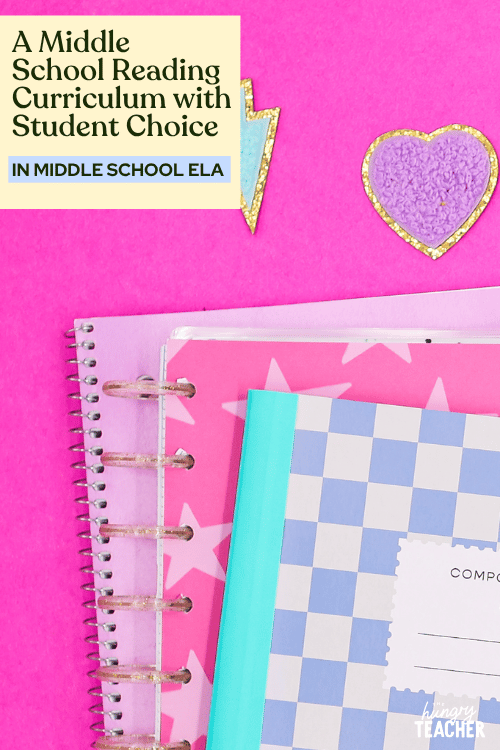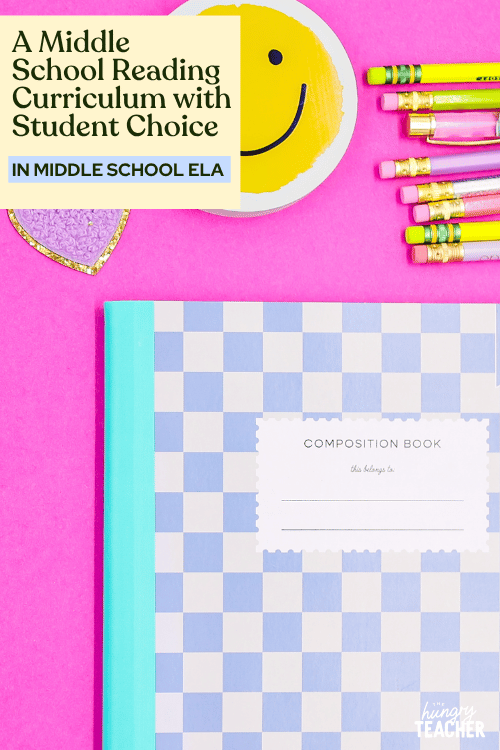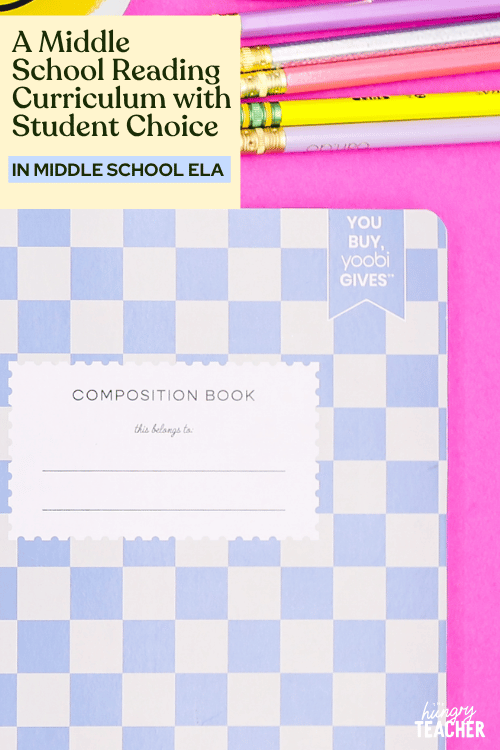hey friend!
I'm Martina.
I provide practical, time-saving strategies that actually work—so you can engage your students, teach effectively, and reclaim your time from the exhausting planning-grading cycle.
Browse Our ELA Resources
A Middle School Reading Curriculum with Student Choice
Getting students engaged in reading isn’t always easy. You have the students who can’t wait to read, and the kids who would rather do anything else. To get all your students on board, you know you need a mix of structure and choice. Students need to be held accountable and given some freedom. It might not seem that there’s a middle school reading curriculum out there that fits the bill – but there is. 😉

The Winning Reading Curriculum Combo
If you’ve ever felt like your students were going through the motions with reading, you’re not alone. Getting students invested in reading is a common challenge. That’s why I set out to create a reading curriculum that doesn’t rely on just one approach. The real magic happens when you bring together this winning combo: book clubs, independent reading, and standard-aligned lessons.
I used this winning combo when I designed the Middle School Reading Achievement Curriculum Collection.
- Book clubs – Students meet in book clubs to discuss and analyze texts with their classmates. Typically, students are given a choice in the kind of book they want to read, and then put into book clubs based on their selections. But you can also use book clubs when the entire class reads the same book. Book clubs are where students apply the skills they were taught during the lesson.
- Independent Reading – This can take place in a book club or be truly solo reading. Independent reading gives students choice and ownership. Instead of book logs and strictly monitoring students’ reading progress, you’ll use this opportunity to help students find and select books they really enjoy – building their love of reading.
- Standard-Aligned Units – My middle school reading curriculum doesn’t just cover all the standards, but it lays out the standards in a way that allows you to dig deep with students. I use an alternating unit format, so you’re focusing on reading skills during the unit – and touching on writing skills.
Middle School Reading Curriculum
Inside the Middle School Reading Achievement Curriculum Collection are six reading units. Unlike your traditional middle school reading curriculum, I’m not cramming in the standards or filling it with sleep-inducing stories. Instead, you’ll use book clubs and independent reading alongside the units, so you’re fostering a love of reading while you enhance students’ reading skills.
Take a peek at the units in this reading curriculum:
Literature and Realistic Fiction Unit
In this unit, students dive into relatable stories (who doesn’t love a main character going through some teenage drama of their own?) while learning to identify and analyze literary devices, character development, and make connections between texts and themselves.
As I keep saying, this isn’t your standard middle school reading curriculum! Students won’t just “sit and get” the unit. Through book clubs, mentor texts, scaffolded reading responses, and more, there are lots of opportunities to think critically about the text and apply what they’ve learned.
Literary Devices and Historical Fiction Unit
Ready to throw some historical fiction in the mix? This middle school ELA curriculum brings together literary analysis and historical events. Students will read historical fiction in their book clubs, like Fever 1793 or A Long Walk to Water, and apply their knowledge of literary devices to stories set in the past. It’s challenging in a good way.
This historical fiction unit in the Middle School Reading Achievement Curriculum Collection uses interactive notebook lessons, reading responding, scaffolded literary analysis, and more to build students’ reading skills.
Nonfiction and Literary Nonfiction Unit
This is your typical nonfiction unit with a twist. Like most nonfiction units, students will analyze nonfiction and dig into author’s purpose, evidence, and more.
But this middle school reading curriculum takes it up a notch by using book clubs and nonfiction texts as opposed to just reading excerpts or articles. They are reading and analyzing complete texts like Brown Girl Dreaming and The Finest Hours. It makes for a much deeper learning experience.

Poetry and Verse Unit
When students finally understand that poetry isn’t all goopy love poems and complicated sonnets, you’ve done the real work. 😉 This unit will give students a thorough foundation on the elements of poetry, poetic devices, figurative language, and more. Then, students will apply that knowledge to their book club verse novels.
Verse novels make poetry a lot more accessible for students because they read like a more traditional story. I’ve included all the daily lessons, reading response prompts, reference pages, and more you’ll need in this middle school curriculum.
Dystopian Literature Unit
This unit is always a hit with students. Maybe it’s the world building or the action, but this unit gets students excited to meet with their book clubs. You can use that engagement and enthusiasm to dig into analysis.
As students read their novels with their book clubs, they’ll explore character motivations, plot development, theme, and more. Using the standard-aligned lesson plans and mentor text, you’ll set students up for success, so they can apply the skills independently.
Introduction to Drama Unit
Last but not least in the Middle School Reading Achievement Curriculum Collection is drama. Whether you decide to go the classic or contemporary route, you’ll dive into stage directions, the elements of drama, dialogue, and more.
Students can read the drama with their book club and even act out scenes. This is a great way to get struggling readers engaged and interacting with the novel. Of course, they’ll also apply what they’ve learned, analyzing the characters, conflict, and plot along the way.

Complete Middle School Reading Curriculum
When you grab the Middle School Reading Achievement Curriculum Collection, you’ll get access to the six reading units I mentioned. Plus bonus resources like curriculum maps and pacing guides, bell ringers, and The Independent Reading Workshop (to help you implement independent reading).
This complete curriculum covers all of the standards you need to teach in your 6-8 grade classroom. I’m giving you all the resources you need to teach these units, including daily lesson plans, interactive notebook lessons, reading response examples, teaching slides, and more.
Want a sneak peek at teaching The Hungry Teacher way—with support, structure, and strategy?
When you join the waitlist for The Hungry Teacher’s Hub membership, you get three free classroom-ready resources: a theme unit, an expository writing unit, and a grammar unit introducing mentor sentences. Plus, you’ll get immediate access to a selection of exclusives from the Hub, including editable sub plans, pacing guides, and more.
No strings attached. Just resources you can use right now—and a heads-up when the Hub opens.
3 Free Middle School ELA Units—yours to keep!
JOIN THE WAITLIST + A FREE GIFT
Where to next, line leader?
Welcome to The Hungry Teacher! We create resources that are easy to use, practical, and get results. Teach with confidence—and make it home before dinner.
xo, the hungry teacher